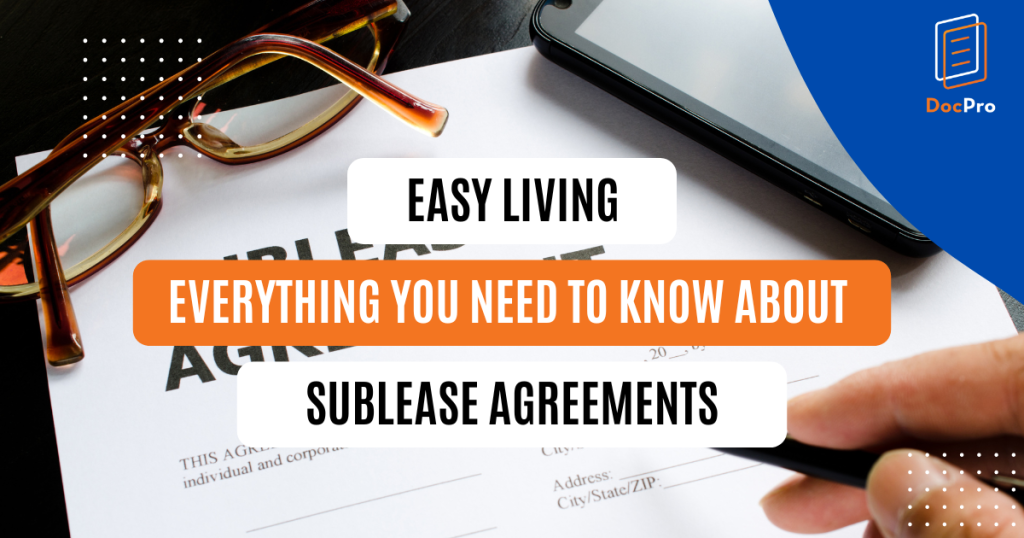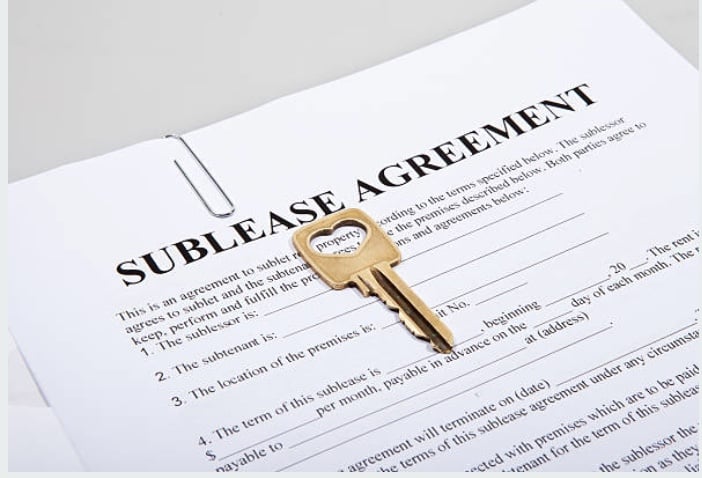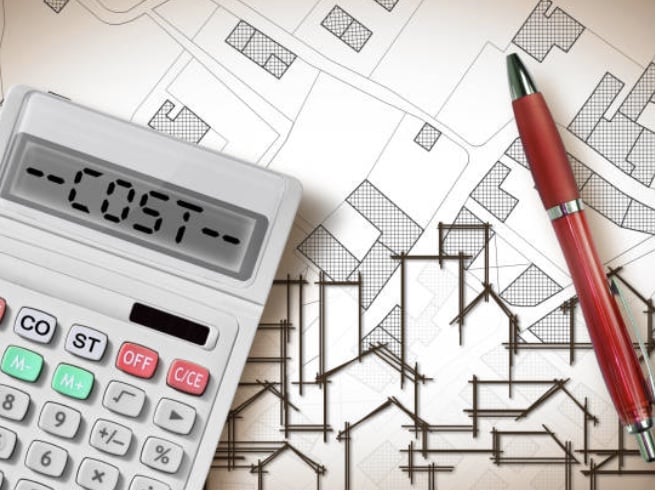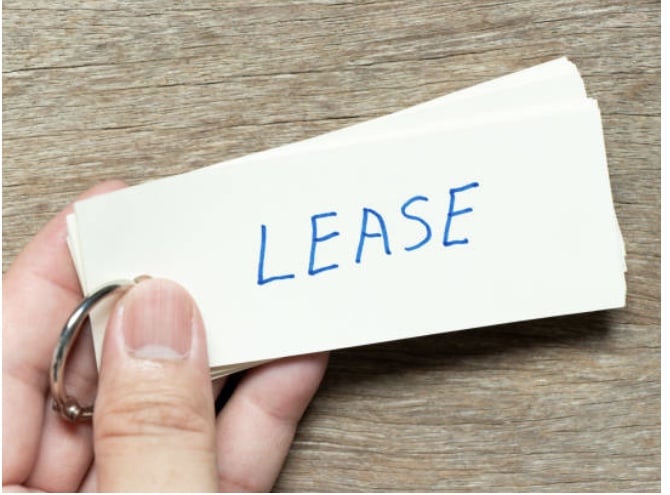Everything You Need to Know about Sublease Agreements
26 Jun 2024
1 May 2024
min read

Everything You Need to Know about Sublease Agreements
While a tenant may have a primary rental contract with a landlord, oftentimes the property under the contract may be re-rented to a third party, known as the sublessee. In such situations, sublease agreements come into play. A sublease agreement is a legally-binding document that governs the relationship between a sublessee, a sublessor, and sometimes the landlord. In this article, we will guide you through the components of a sublease agreement, as well as provide you with DocPro’s tailor-made Sublease Agreement templates.
Understanding Sublease Agreements
A sublease agreement is a formal, legally-binding contract signed between a tenant and a third party (the sublessee) which allows the latter to rent out the entire property or any part of it. It usually involves a tenant who originally rents a property from a landlord. Then, the tenant re-rents part or the whole of the property to a third party, i.e. the sublessee, who will bear the same responsibilities as the tenant previously had.
A proper sublease agreement should outline the terms and conditions of the sublease, and all parties involved should fully understand the clauses and provisions included in the agreement before signing it. Oftentimes this means informing the original landlord about the sublease arrangement and having his or her consent to the sublease agreement. It is important for all parties involved in such arrangement to understand their obligations, responsibilities, and legal rights.
The success of a sublease arrangement depends first on both of the tenants comprehending their respective rights and duties and then on them adhering to the terms of the sublease agreement, says Allyson Gagliardi, Legal Practice Director at Rockwell Family Law

Why a Sublease Agreement?
For the sublessor, subleasing is advantageous as it allows him or her to earn income from a property he or she may have to vacate early. In some occasions, a sublease agreement may even allow the sublessor to share rental expenses with the sublessee. Hunter Garnett[1], an attorney in Huntsville, Alabama, shared his experience on subleases in a commercial setting. At his law firm, he rented an office with approximately 2,000 sf when he only needed 1,500 sf. To generate supplemental income, he subleased the extra office space to a psychiatrist. The sublease agreement generated income for Hunter, as well as prevented the wasting of extra office space.
On the other hand, subleasing is also beneficial to the sublessee, as it can provide an affordable accommodation option with greater flexibility than a traditional lease. Rent is usually lower under a sublease agreement, while subleases are typically shorter-term arrangements, meaning the sublessee can move out at the end of the sublease period without incurring penalties.
Alana Gibson, Chief Operating Officer at DGR Legal, one critical advantage of sublease agreements is their capacity to mitigate financial risk. For businesses experiencing unexpected downturns, subleasing provides an opportunity to reduce overheads without breaching lease agreements.
What to Look for in a Sublease Agreement?
A sublease agreement involving only the sublessee and the sublessor may look different from one that involves the landlord as an additional party. Below is a summary of essential components to be included in a sublease agreement between a sublessee and a sublessor, with example clauses taken from DocPro’s original Sublease Agreement templates.
Subleasing can affect both the sublessor and sublessee's insurance policies. Making sure everyone has proper coverage for the arrangement is really important and may require policy changes, according to Ashley Connell, a solicitor and founder of Lease Extensions, and a member of ALEP (Association of Leasehold Enfranchisement Practitioners
Between Sublessee and Sublessor Only
1 Party Names
An important element of any contractual document is the names of the parties involved. Sublease agreements are no exception. For a contract governing the relationship between a sublessee and a sublessor, it is necessary to make sure that their names are accurately recorded in the written agreement.
2 Period of the Sublease
Subleasing a part of, or the whole of, a property means having the sublessee live or occupy the subleased space. Like any rental contract, the period of sublease has to be precisely and clearly stated so that both parties have a consensus on when the sublease shall commence, as well as when it should end. Our template on Sublease Agreement (Sublessee and Sublessor) provides the following clause for this purpose:
2.1 This Sublease Agreement shall commence on (Commencement Date) and
will terminate on (End Date). There shall be no holding over under the terms
of this Sublease agreement under any circumstances.
3 Rights of the Sublessee and the Sublessor
For both the sublessee and the sublessor, it is important to understand their respective rights and obligations. For example, the sublessor should have the right to take back any premises or property subleased to the sublessee on termination of the sublease agreement:
2.2 The Sublessor has the right to take back the Premises in full, and the
Sublessee must deliver vacant possession of the Premises on termination of
this Agreement.
For the sublessee, provided that he or she pays the rent accordingly, he or she should be entitled to peacefully hold and enjoy the subleased premises or property without interruption by the sublessor during the sublease period:
2.3 Provided the Sublessee shall have paid the Rent and other outgoings
on the days and in the manner herein provided…the Sublessee shall
peacefully hold and enjoy the Premises during the Term of this Agreement
without any interruption by the Sublessor.
4 Rent

Rent is definitely one of the major concerns for anybody involved in a sublease relationship. Therefore, a section dedicated to rent is needed in a proper sublease agreement. In our template, a provision is included to indicate the cost of rent, as well as the coverage of such rent:
3.1 The rent is (Currency) (Rent) on a (Period) basis, the rent included
Furniture and Electrical Appliances, and other items and fees as listed in the
Schedule.
Note that a Schedule is provided in our template for users to indicate the items and types of furniture covered by the rent pursuant to the above clause in the ‘Rent’ section.
5 Reference to Original Lease
A sublease normally operates under a pre-existing primary lease between the sublessor and the landlord. Under the sublease, the sublessee is also required to assume all rights and obligations of the sublessor, i.e. the tenant under the original lease. To ensure that this point is clearly noted, a clause in our template provides that:
5.2 The Sublessee expressly assumes all rights and obligations of the Tenant
under the Lease and agrees to comply with all rules, regulations, and
requirements imposed by the Landlord in the Lease…
It is also important to point out that the sublessee has to bear the consequences and responsibilities of any breach of the terms and conditions of the original lease between the sublessor (a.k.a. the tenant) and the landlord:
5.3 The Sublessee further acknowledges that any breach of the Lease by the
Sublessee shall constitute a default under this Agreement, entitling the
Sublessor to exercise any remedies available to the Landlord under the Lease.
Compare with an Agreement involving Sublessor, Sublessee and Landlord
A sublease agreement involving the landlord as an additional party generally contains the above clauses and components. However, the two sub-categories of sublease agreements differ on certain fine details. For example, a sublease agreement involving the landlord would include the landlord’s name as one of the parties, while a sublease agreement involving only the sublease and sublessor would include a section indicating the landlord’s consent to the sublease arrangement. For more information, take a look at our template on Sublease Agreement (Sublessor, Sublessee and Landlord) to learn more.

Frequently Asked Questions
What is a sublet agreement for?
A sublet agreement is the same as a sublease agreement. It is a contract under which a tenant rents out his or her property to another individual but retains his or her status as a tenant under the primary lease.
Is subletting (or subleasing) legal?
If the tenancy document does not contain a clause that restrains a tenant from subletting, then the mere act of doing so, even without the landlord’s consent, is NOT illegal per se. Since the landlord’s interests in the property are passed to the tenant during the tenancy period, the tenant may deal with the property in whatever manner as if he or she owned the property, including subletting the property to a sublessee.
What is the different between a sublease and an assignment?
Assignments and subleases are both terms for situations in which a tenant in possession of a property transfers his or her rights in that property to a third party. If the tenant transfers his or her entire remaining interest in the tenancy to the third party, it is called an assignment. If the tenant transfers only part of his or her interest, the transfer is known as a sublease.
[1] Hunter Garnett, Injury Lawyer, Garnett Patterson Injury Lawyers, Huntsville, Alabama, US
Keywords:
